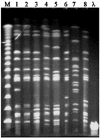Characterization of Salmonella enterica serovar Typhimurium and monophasic Salmonella serovar 1,4,[5],12:i:- isolates in Thailand
- PMID: 15956391
- PMCID: PMC1151962
- DOI: 10.1128/JCM.43.6.2736-2740.2005
Characterization of Salmonella enterica serovar Typhimurium and monophasic Salmonella serovar 1,4,[5],12:i:- isolates in Thailand
Abstract
Duplex PCR was developed to screen Salmonella enterica serovar Typhimurium phage type DT104 and related strains in Thailand because a phage typing laboratory of serovar Typhimurium is not available. Of 46 isolates of serovar Typhimurium and 32 isolates of S. enterica serovar 1,4,[5],12:i:-, 15 (33%) and 30 (94%) were duplex PCR positive, respectively. All isolates were submitted for phage typing to analyze the specificity of the PCR assay. Among serovar Typhimurium isolates that yielded positive duplex PCRs, only seven isolates were phage types DT104 or U302, and eight isolates were undefined types, whereas the negative PCR isolates were either other phage types, including DT7, DT12, DT66, DT79, DT166, DT170, DT193, and DT208 or an undefined type. The serovar Typhimurium and serovar 1,4,[5],12:i:- isolates that were duplex PCR positive were further subtyped by using XbaI PFGE to reveal their genetic relatedness. All serovar Typhimurium phage type DT104 strains had indistinguishable chromosomal patterns. The isolates of phage type U302 and most of the serovar 1,4,[5],12:i:- isolates that were duplex PCR positive yielded similar pulsed-field gel electrophoresis patterns. The patterns of PCR-negative isolates distinctly differed from the patterns of PCR-positive isolates. A total of 26% of all isolates had a dominant R-type ACSSuTG that was not found in the isolates of phage type DT104.
Figures


References
-
- Akkina, J. E., A. T. Hogue, F. J. Angulo, R. Johnson, K. E. Petersen, P. K. Saini, P. J. Fedorka-Cray, and W. D. Schlosser. 1999. Epidemiologic aspects, control, and importance of multiple-drug resistant Salmonella Typhimurium DT104 in the United States. J. Am. Vet. Med. Assoc. 214:790-798. - PubMed
Publication types
MeSH terms
Substances
LinkOut - more resources
Full Text Sources
Medical

